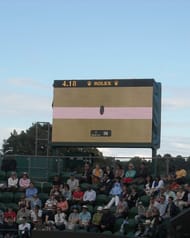Over the past few decades, changing rules, technological innovations and the lucrative prize money of tennis have all contributed towards keeping the sport commercially viable.
Causing a racquet
Indeed, tennis has come a long way since its nascent days in the early 1870s when wooden racquets were in vogue. Some forty years later, they were replaced by the laminated tennis racquet. The sport treaded down a new path in the late 1960s when Wilson introduced the first steel racquet named the T2000. This proved to be a massive commercial success and was even used by American legendary southpaw Jimmy Connors when he clinched the Wimbledon singles titles in 1974 and 1981.
The mid-1970s saw the Prince brand roll out the oversized tennis racquet with an aluminium frame. These panned out to be a big draw as it allowed the players to hit the ball with more spin or slice due to their enhanced head sizes, light weight and huge sweet spot.
Then the eighties saw the introduction of the first graphite tennis racquets. Constructed from a stiffer frame material that mixed carbon fibres with a plastic resin, they were lighter, stiffer and allowed players to hit the ball harder. Dunlop Max 200G was perhaps the most famous among the early graphite racquets used in the eighties – famously used by the illustrious John McEnroe and Steffi Graf.
Wilson introduced the first widebody racquet in 1987 – it enabled the players to employ more powerful shots. The Prince brand was again at the forefront, unveiling the O3 technology in 2005 to improve racquet speed. It dramatically increased the size of the sweet spot again without increasing the size or length of the racquet, weight or string tension. Racquets in contemporary times are also made from graphite although a different grade is used.
Having a ball
Tennis balls have also undergone changes over the years. The white balls used to be the order of the day for a long period of time, before yellow tennis balls were introduced in 1972 because they were easier to see on colour televisions. Yellow balls were a big “no” at Wimbledon for decades before they were first used at the courts in 1986.
Grass was greener
Tennis was predominantly played on grass until at least the seventies before clay and hardcourt surfaces came to the fore. Among the Grand Slams, grass was a permanent feature at Wimbledon, while the Australian Open and US Open were initially played on grass till the early seventies and late eighties before they were replaced by hardcourts.
The French Open was the only Grand Slam to be played on clay – even the US Open was also played on clay for a few years in the seventies. In fact, it emerged as a popular surface mostly for the European and South American nations. The hardcourts also started gaining popularity in the mid-seventies with the US Open being played on DecoTurf since 1978. The surfaces came into prominence at the Australian Open. The first green Rebound Ace surface was used from 1988 till 2007 before the blue Plexicushion replaced it from 2008.
The sport also went high-tech. In the early nineties IBM first implemented service speed technology at Wimbledon. Electric line-calling technology Hawk-Eye was first used at the British courts in 2006 to capture the ball as it travels and create a model of the field of play.

Up to speed
IBM unveiled the SecondSight analytics tool at the 2011 Wimbledon Championships – this tool tracks players’ movement, stamina, distance covered and style of play. The IBM SlamTracker technology was rolled out at Wimbledon in 2013 – this tool provides coaches and players with an accurate real-time overview of the results of all other matches, along with data for eight previous Wimbledon tournaments.
The 2014 Australian Open had an extra dose of excitement for its fans, who were able to step into a virtual reality tennis court using the power of the Oculus Rift headset. They were handed a specifically designed motion-sensitive tennis racquet and were challenged to return a virtual serve from the best tennis players on earth.
Clearly, tennis has radically evolved over the decades, renewing its novelty that its fans quickly embrace.
What changes would you like to see in tennis, or is the game perfect in your eyes? Share your comments below.
Originally published on the Champions Tennis League site here.


